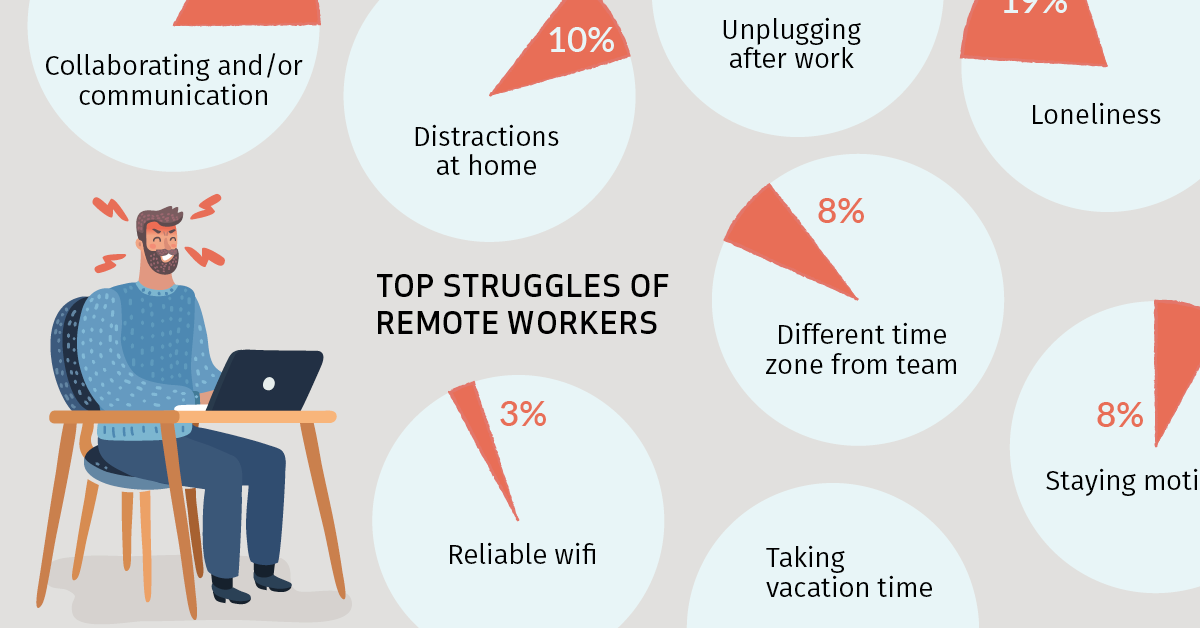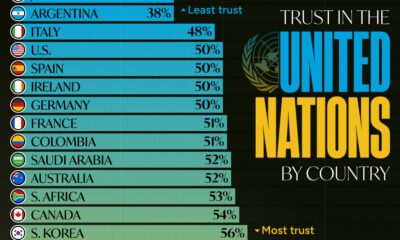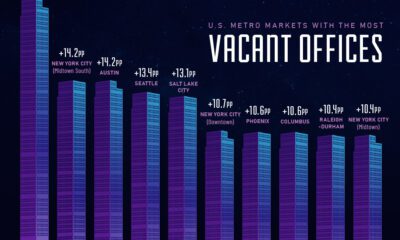Datastream
The Top Struggles of Remote Workers

The Briefing
- The top challenge remote workers face is unplugging from work, followed by loneliness, and communicating with coworkers.
- Despite these challenges, 98% of remote workers wish to continue working remotely, at least some of the time.
The Top Struggles of Remote Workers
Unplugging from work can be challenging at the best of times.
But when your living room doubles as your office, it can be even harder–at least that’s the case for 22% of remote workers.
Thanks to the global pandemic, millions of workers have been sent home to work at a safe distance. While many remote workers enjoy the flexibility that comes with remote work, it doesn’t come without its drawbacks.
Here’s a ranking of the top struggles that remote workers face, according to a recent report by Buffer and AngelList:
| Rank | Challenge | % of Respondents |
|---|---|---|
| 1 | Unplugging from work | 22% |
| 2 | Loneliness | 19% |
| 3 | Collaborating and/or communicating | 17% |
| 4 | Distractions at home | 10% |
| 5 | Different time zones from team | 8% |
| 6 | Staying motivated | 8% |
| 7 | Taking vacation time | 7% |
| 8 | Reliable WiFi | 3% |
The report also found that only 15% of employers paid the cost of home internet, and 21% covered the cost of a phone plan in a work-from-home situation. However, with this type of arrangement still being relatively new for most, these perks could evolve over time.
Despite the various challenges involved, 98% of remote workers would like to continue working remotely, at least some of the time, for the rest of their careers.
In short—while remote work poses its own set of struggles, the benefits outweigh the cons.
»For a more in-depth look at the topic of remote work, visit: How People and Companies Feel About Working Remotely.
Where does this data come from?
Source: The State of Remote Work Report, from Buffer and AngelList
Details: Survey results from 3,500 remote workers from across the globe.
Notes: This report was published in February of 2020 and the data was collected in November of 2019.
Datastream
Can You Calculate Your Daily Carbon Footprint?
Discover how the average person’s carbon footprint impacts the environment and learn how carbon credits can offset your carbon footprint.

The Briefing
- A person’s carbon footprint is substantial, with activities such as food consumption creating as much as 4,500 g of CO₂ emissions daily.
- By purchasing carbon credits from Carbon Streaming Corporation, you can offset your own emissions and fund positive climate action.
Your Everyday Carbon Footprint
While many large businesses and countries have committed to net-zero goals, it is essential to acknowledge that your everyday activities also contribute to global emissions.
In this graphic, sponsored by Carbon Streaming Corporation, we will explore how the choices we make and the products we use have a profound impact on our carbon footprint.
Carbon Emissions by Activity
Here are some of the daily activities and products of the average person and their carbon footprint, according to Clever Carbon.
| Household Activities & Products | CO2 Emissions (g) |
|---|---|
| 💡 Standard Light Bulb (100 watts, four hours) | 172 g |
| 📱 Mobile Phone Use (195 minutes per day)* | 189 g |
| 👕 Washing Machine (0.63 kWh) | 275 g |
| 🔥 Electric Oven (1.56 kWh) | 675 g |
| ♨️ Tumble Dryer (2.5 kWh) | 1,000 g |
| 🧻 Toilet Roll (2 ply) | 1,300 g |
| 🚿 Hot Shower (10 mins) | 2,000 g |
| 🚙 Daily Commute (one hour, by car) | 3,360 g |
| 🍽️ Average Daily Food Consumption (three meals of 600 calories) | 4,500 g |
| *Phone use based on yearly use of 69kg per the source, Reboxed | |
Your choice of transportation plays a crucial role in determining your carbon footprint. For instance, a 15 km daily commute to work on public transport generates an average of 1,464 g of CO₂ emissions. Compared to 3,360 g—twice the volume for a journey the same length by car.
By opting for more sustainable modes of transport, such as cycling, walking, or public transportation, you can significantly reduce your carbon footprint.
Addressing Your Carbon Footprint
One way to compensate for your emissions is by purchasing high-quality carbon credits.
Carbon credits are used to help fund projects that avoid, reduce or remove CO₂ emissions. This includes nature-based solutions such as reforestation and improved forest management, or technology-based solutions such as the production of biochar and carbon capture and storage (CCS).
While carbon credits offer a potential solution for individuals to help reduce global emissions, public awareness remains a significant challenge. A BCG-Patch survey revealed that only 34% of U.S. consumers are familiar with carbon credits, and only 3% have purchased them in the past.
About Carbon Streaming
By financing the creation or expansion of carbon projects, Carbon Streaming Corporation secures the rights to future carbon credits generated by these sustainable projects. You can then purchase these carbon credits to help fund climate solutions around the world and compensate for your own emissions.
Ready to get involved?
>> Learn more about purchasing carbon credits at Carbon Streaming
-

 Real Estate2 weeks ago
Real Estate2 weeks agoVisualizing America’s Shortage of Affordable Homes
-

 Technology1 week ago
Technology1 week agoRanked: Semiconductor Companies by Industry Revenue Share
-

 Money2 weeks ago
Money2 weeks agoWhich States Have the Highest Minimum Wage in America?
-

 Real Estate2 weeks ago
Real Estate2 weeks agoRanked: The Most Valuable Housing Markets in America
-

 Business2 weeks ago
Business2 weeks agoCharted: Big Four Market Share by S&P 500 Audits
-

 AI2 weeks ago
AI2 weeks agoThe Stock Performance of U.S. Chipmakers So Far in 2024
-

 Misc2 weeks ago
Misc2 weeks agoAlmost Every EV Stock is Down After Q1 2024
-

 Money2 weeks ago
Money2 weeks agoWhere Does One U.S. Tax Dollar Go?


















